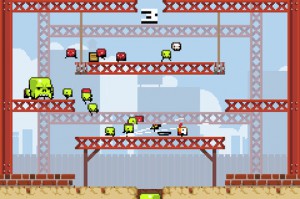 Hats off to Vlambeer for making Super Crate Box. A great single screen platformer. Before it was nominated for a design award at the IGF it was nominated for love by the judge in my heart. And in my heart it took the grand prize.
Hats off to Vlambeer for making Super Crate Box. A great single screen platformer. Before it was nominated for a design award at the IGF it was nominated for love by the judge in my heart. And in my heart it took the grand prize.
I found Super Crate Box while we were in Honduras and when you’re at the end of an impassable dirt road with no TV and spotty Internet what you really need on your hard-drive is a good super-hard game with both running and gunning. I played the hell out of it and am proud to have 100% unlocked everything.
So why is it so fun? To answer that it would be helpful if you had at least a passing understanding of Super Crate Box (no I will not be acronyming that). There’s really no reason I should have to describe it to you. Just go play It. It’s free and more fun than reading.
 During my Super Crate Box phase we made a trip to Pigeon Keys with our friends Julie and Ed who run Radical Adventures. It was an amazing trip! We’d done a lot of snorkeling before but the waters off Pigeon Keys were perfectly clear. So clear it was like there was no water at all and we were flying 10 meters over the ground in a giant beautiful Catamaran pointing out fish and rays like you might point out birds. Diving off the boat became like bungee jumping. This one novel twist on an experience we had had many times before made it go from fun to once-in-a-lifetime amazing. Our brain loves to be in a familiar situation with a twist because it loves to learn.
During my Super Crate Box phase we made a trip to Pigeon Keys with our friends Julie and Ed who run Radical Adventures. It was an amazing trip! We’d done a lot of snorkeling before but the waters off Pigeon Keys were perfectly clear. So clear it was like there was no water at all and we were flying 10 meters over the ground in a giant beautiful Catamaran pointing out fish and rays like you might point out birds. Diving off the boat became like bungee jumping. This one novel twist on an experience we had had many times before made it go from fun to once-in-a-lifetime amazing. Our brain loves to be in a familiar situation with a twist because it loves to learn.
Video games are about learning and our brains do a lot of learning through pattern matching. When we have a decision to make we compare the situation to previous situations we’ve been in. If we can can find an identical one and we know how to solve it then we just do the same thing we did back then. If we can’t associate it with a previous situation at all we panic and do something random. But if it’s similar but slightly different to a previous situation, or better, is a combination of previous situations then we get creative. We try a combination of stuff that worked before. And this can be genius. This is an incredibly powerful tool evolutionarily so it makes sense that our brain likes to do it and it’s fun.
Super Crate Box is in the business of giving us these slightly-different problems to tackle. It has dedicated its life to this task and I applaud it for its selfless dedication to making me joyful. It manages this by taking a simple proven game (jumping around and shooting stuff) and combining it with a dizzying array of weapons, all of which are slightly different from each other. “But that’s hardly new, lots of games have a dizzying array of weapons” you say. Yes that is true, imaginary reader in my head, you are correct. But Super Crate Box knows you’re too shitty a game designer to use them properly.
 Games are about learning and our brain really likes to learn. But it doesn’t like to learn just any old things. It likes to learn helpful useful things. It wants to learn how to win! Most games with a dizzying array of weapons let you chose which ones you want to play with. Super Crate box recognises this as a fault. The better you get with a weapon in Super Crate Box the less you play with it. The better you are with a weapon the more ruthlessly efficient you are at getting to the next crate and the next random weapon. In this way Super Crate Box refuses to let you specialise. It refuses to let you get good with one weapon and ignore all the others, which is how I (and I assume most people) play all those games with a dizzying array of weapons. We play games that way because our brain recognises that its often more efficient to get better with something we understand than to start over learning something we don’t. Unfortunately that’s less fun but our brain is a shitty game designer.
Games are about learning and our brain really likes to learn. But it doesn’t like to learn just any old things. It likes to learn helpful useful things. It wants to learn how to win! Most games with a dizzying array of weapons let you chose which ones you want to play with. Super Crate box recognises this as a fault. The better you get with a weapon in Super Crate Box the less you play with it. The better you are with a weapon the more ruthlessly efficient you are at getting to the next crate and the next random weapon. In this way Super Crate Box refuses to let you specialise. It refuses to let you get good with one weapon and ignore all the others, which is how I (and I assume most people) play all those games with a dizzying array of weapons. We play games that way because our brain recognises that its often more efficient to get better with something we understand than to start over learning something we don’t. Unfortunately that’s less fun but our brain is a shitty game designer.
By forcing us into a situation we’ve already been in but with an unfamiliar weapon Super Crate Box gives us a problem we can tackle creatively. And when we succeed at one of these problems it feels great! In fact it’s probably possible to mathmatically determine the number of possible situations and therefore the number of situates which should be contained in the perfect game (assuming Super Crate Box is the perfect game). Say there are 15 weapons (amazingly I can’t find a list) and say there are 40 unique board states (I’m pretty much just making that up) that means there are 600 totaly states. So take a look at your favorite game or the game your making and count the states. 600 = IGF Design Nomination!
Anyway, once more doff your hat to Raimi Ismail and Jan Willem Nijman for being smarter than the human brain and giving us all something slightly different to play.
Also thanks that there is this


Comments
3 responses to “Super Crate Box tells us the magic number is 600”
I found myself playing SCB the other day for the first time, and thinking to myself “this game is genius!”, but for somewhat different reasons…
So a lot of gameplay has to do with economics, in the academic sense: the study of optimizing the usage of scarce resources. Sometimes these resources are literally called resources, and your little guys have to harvest them as fast as they can, and you have to optimize how you spend them. SCB is great because it turns this sideways. The item you are traditionally optimizing for (ammo/lives) is limitless, so instead you must optimize for the next-most-scarce resource, which is time. Since the flow of enemies never stops, and since the cost of not killing enemies is steep (and will eventually overwhelm you), every millisecond becomes an exercise in time management. Do you jump down to the lower level to get the next crate, or do you kill the guys on the platform above? How can you most effectively take out a series of guys above while you still have a good weapon, before risking switching to another? etc. This changes the essential nature of SCB from a twitchy action game to something more strategic (though, of course, still twitchy and actiony).
This also has direct importance on the weapon variety in the game. Initially the mines and disc gun seem pointless, but with some practice you realize that because their action is delayed, they are the only two weapons that let you manage two levels of the map at the same time (where you are, and where you were when you dropped the mine/shot the disc). In some ways this makes them more compelling then the other weapons, though I still generally kill myself every time I get the disc gun :)
SCB isn’t the first game to make time a scarce resource, but I can’t think of many games that do it as effectively as SCB. In other games it feels forced, or added only to increase the game difficulty (“You must pass this level in 90 seconds!”).
OK that’s enough from me.
Oh very interesting I had not thought about the game in terms of resource optimisation.
Which is interesting because with some weapons you can “break” that resource and stay alive forever by clearing the screen and camp the top. You’re not progressing at that point but any tool that lets you break the primary resource is powerful.
My strategy is to go from clearing weapon to clearing weapon as quickly as possible but every time I get a clearing weapon I empty the whole screen with no exceptions. To improve at the game I turned more and more weapons into clearing weapons.
I also wanted to talk about the game as a slot machine. You can improve your ods with skill but it’s a pretty pure slot machine. No player could deal with ten dual pistols in a row.
What a fascinating take on brain optimization of weapon use. It is my natural inclination to stick to one weapon and be very good at it, although I always want to try out the other weapons because…well because they’re there!
Will definitely try out Super Crate Box now to see if it really does fix this problem for me.